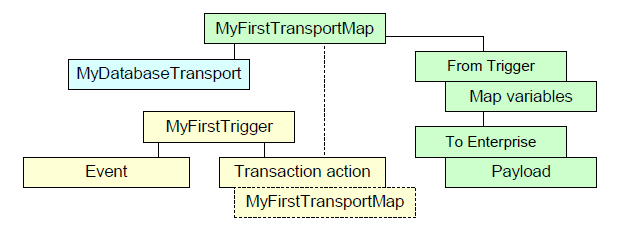You can think of a transport map as the mapping (or
organization) of plant floor data into a format that the
enterprise application expects. A transport map is
comprised of its name, a previously defined transport, map
variables (the runtime data from the trigger), and payload
(the data that is delivered to the enterprise application).
The transport map is specified within a trigger as a
Transaction action to be executed whenever
an event occurs. The following illustrates these
components.
Combined, these components produce the communication
between the production controller and the endpoint
enterprise application program. The Workbench provides the
means to enable the process to produce these components as
follows:
- Create a transport. The transport is created before the transport map is created. The transport provides the protocol that is used to transfer the data. For more information, click Transports.
- Create a transport map and define the map variables and payload. All transport maps require a transport. The transport that is specified (for example a database transport) determines the parameters to set for the transport map.
- Create a trigger and then add the Transaction action (the transport map). The trigger is associated with the transport map and provides the event type and perhaps one or more conditions.
1Transport map authorization
In order to use the information in this chapter, you must have been given full transport map authorization. You must be able to view, add, edit, and delete a transport map.